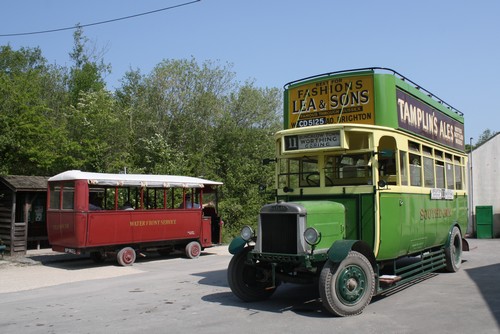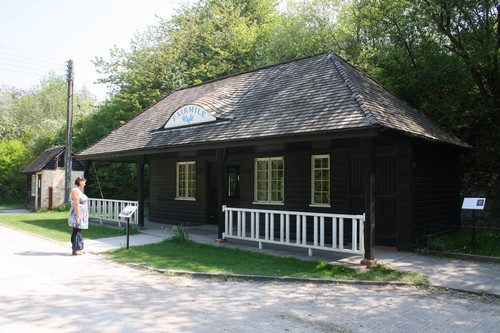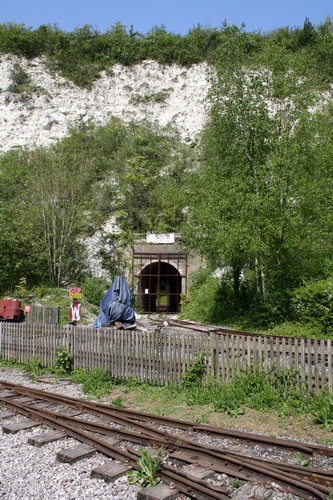Jayne and I went to Amberley museum for the second time in three days today. They do a deal whereby if you keep hold of your tickets you can return for free within 5 days, so we did. When we went on Saturday we left without seeing everything because we had to do some supermarket shopping and get home before Doctor Who the kids visited.
Really we are making the most of what may be the last time we will both be off work at the same time for a couple of days, now that Jayne has a new job that involves working at weekends.
The museum is worth a second visit anyway, and it is handy if you are close enough to do it in two halves rather than spend all day in one place.The museum is described on roadsigns and Amberley Working Museum, although in the guide book it admits that the place doesn’t have a real theme as such. It is based around an old quarry and limeworks and features a lot of the features from that including the original engine sheds, lime kilns, workshops and so on, but has expanded to include other areas of industry in the South-East like timber working, pottery and printing and then to include displays about electricity, road-building, telecommunication and cycling.
The most specific they will get is that it ‘most’ of what is on display relates to the last 100 to 150 years and relates to industry but I reckon that if they got offered anything that didn’t fit in (suits of armour, a dinosaur skeleton, a Tiger tank, a Shakespeare first folio, 17-Century animal traps, a collection of early string instruments) they would somehow find a way to make it fit or use it for swapsies with another museum.
What was surprising was how quiet it all was for a bank holiday weekend. Maybe everybody headed for the beach or something, but it there were very few visitors on both days.
In a way this was great because there were no queues for anything and you could take photographs without having to wait for people to get out of the way.
The downside was that quite a few exhibits were unmanned that would normally have demonstrations of various crafts and trades. A lot of the old machinery is kept running by volunteers and you can see them working on restoration, demonstrating how they work and in the case of vehicles taking them for a spin.
That is not to say the place was dead: there were steam trains, buses and traction engines running, people showing how various printing presses work, and somebody operating the amateur radio station, but on busier days there would be lots more – people making walking sticks, potters, bodgers, blacksmiths and the rest.
The place really is an anorak’s paradise though. It contains most of the sort of things that people get anorak-y about: loads of old buses, vans fire engines and cars, large pumps other engines and machines, steam trains and even some of the more obscure things that people get excited about – lots of vintage postboxes and telephone boxes for example.  The telecoms building even had something for those who get weak at the knees over the sight and sound of Straugers doing their thing.
As well as the original industrial buildings from the site, there are quite a few buildings rescued from elsewhere either completely or just the contents. So there is an old transport cafe, a bus station ticket office, the interior of an old-fashioned cobblers all on site as well as some impressive switchboards and power control boards.
One particular part of the site should be familiar to James Bond fans because the tunnel entrance there was used in possibly the naffest of all the James Bond films, A View To A Kill. It was used for the exterior scenes of the mine where Max Zorin was going to set off loads of explosives to sink half of California.
In fact some of the rolling stock for the narrow gauge railway system is still painted in the Zorin Industries livery from when it was used in the film.
No matter how interested we are in how other people lived and worked in the past, I think we all also have a bit of a weakness for reminders of our own past and this museum caters for that too.
In the TV and radio shop there is an astonishing number of old equipment, including enormous old VHS machines – were they really that big?   Great to look around and recognising an old radiogram similar to one you remember your parents or an aunt having and for pondering on how much better home AV equipment is these days.
I wonder whether our children might come here in their middle age, bringing their children and showing them examples of the clunky old DVD players they used to have or the laughavly old-fashioned mp3 players.
An even better place to indulge in such nostalgia is the electricity exhibition. There are some very old appliances there, but more than a few that I recognise from childhood: a spherical vacuum cleaner that I am sure we used to have one of for example. They even had a boxed up Sinclair Spectrum to really get me going – although it was the pristine Morris Minor out of everything on the site that I was most keen on.
I reckon this would be a good place to take kids and elderly relatives together. The oldies can go into fits of “Ooh I remember using one of those” and “we used to have one of those at work” while the kids can enjoy the rides on buses, pressing the buttons on the interactive displays, and so on.
Something for everybody is a bit of a cliche, but I would be surprised if anybody couldn’t find something here that interested them and, although we drove, it is easily accessible by train – the railway station and the museum share a car park.







I would go weak at the knees as well over “The telecoms building even had something for those who get weak at the knees over the sight and sound of Straugers doing their thing.” As the equipment is actually called “Strowger”…. I may not go weak at the knees at it but as I worked on various forms of it when I first went to work for the then Post Office Telecommunications (now BT) in 1971 it has a real nostalga pull for me.
As an aside the Strowger system was designed by one Alman B Strowger, an American Undertaker, who designed the automatic telephone system as a way of getting more business for himself as his rival’s wife was the local telephone operator who diverted all “I need an undertaker” calls to her husband.
For a real anorak look for the story of it’s invention go to
http://hubtechinsider.wordpress.com/2009/04/28/the-amazing-untold-and-completely-true-story-of-the-strowger-switch/
Again, as an aside, if it was not for the original Strowger design we would not have had the Post Office 3000 type relay that was used in it in later versions in this country and RAF Bletchley would not have been able to decode the enigma signals from nazi Germany as a result as they used that relay as the basis of the decoding machines……. :-))